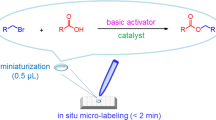Abstract
A procedure for the detection of homocysteine (Hcy) in blood plasma is described. A commercially available chromogen is added to the plasma sample. The plasma solution turns from yellow to blue upon heating for 4 min when a detectable threshold level of Hcy is present. Chromatographic separations and immunogenic materials are not needed. The protocol takes ∼30 min.
This is a preview of subscription content, access via your institution
Access options
Subscribe to this journal
Receive 12 print issues and online access
$259.00 per year
only $21.58 per issue
Buy this article
- Purchase on Springer Link
- Instant access to full article PDF
Prices may be subject to local taxes which are calculated during checkout


Similar content being viewed by others
References
Haugland, R.P. Thiol-reactive probes. In Molecular Probes – Handbook of Fluorescent Probes and Research Products 9th edn. (ed. Gregory, J.) 79–93 (Molecular Probes, Inc., Eugene, Oregon, 2002).
Ivanov, A.R., Nazimov, I.V. & Baratova, L.A. Qualitative and quantitative determination of biologically active low-molecular-mass thiols in human blood by reversed-phase high-performance liquid chromatography with photometry and fluorescence detection. J. Chromatogr. A 870, 433 (2000).
Fermo, I. et al. High-performance liquid chromatographic method for measuring total plasma homocysteine levels. J. Chromatogr. B 31, 779 (1998).
Wu, C.-W., Yarbrough, L.R. & Wu, F.Y.H. N-(1-pyrene)maleimide: a fluorescent crosslinking reagent. Biochemistry 15, 2863 (1976).
Shimada, K. & Mitamura, K. Derivatization of thiol-containing compounds. J. Chromatogr. B 659, 227–241 (1994).
Nekrassova, O., Lawrence, N.S. & Compton, R.G. Analytical determination of homocysteine: a review. Talanta 60, 1085–1095 (2003).
Refsum, H. et al. Facts and recommendations about total homocysteine determinations: an expert opinion. Clin. Chem. 50, 3–32 (2004).
Refsum, H., Ueland, P.M., Nygård, O. & Vollset, S.E. Homocysteine and cardiovascular disease. Annu. Rev. Med. 49, 31–62 (1998).
Seshadri, S. et al. Plasma homocysteine as a risk factor for dementia and Alzheimer's disease. N. Engl. J. Med. 346, 476–483 (2002).
Lentz, S.R. & Haynes, W.G. Homocysteine: a clinically important cardiovascular risk factor? Cleveland Clinic J. Med. 71, 729–734 (2004).
Shipchandler, M.T. & Moore, E.G. Rapid, fully automated measurement of plasma homocyst(e)ine with the abbott imx analyzer. Clin. Chem. 41, 991–994 (1995).
Pernet, P., Lasnier, E. & Vaubourdolle, M. Evaluation of the AxSYM homocysteine assay and comparison with the Imx homocysteine assay. Clin. Chem. 46, 1440–1441 (2000).
Zhao, R., Lind, J., Merényi, G. & Eriksen, T.E. Kinetics of one-electron oxidation of thiols and hydrogen abstraction by thiyl radicals from alpha-amino C-H bonds. J. Am. Chem. Soc. 116, 12010–12015 (1994).
Wang, W., Escobedo, J.O., Lawrence, C.M. & Strongin, R.M. Direct detection of homocysteine. J. Am. Chem. Soc. 126, 3400–3401 (2004).
Wang, W. et al. Detection of homocysteine and cysteine. J. Am. Chem. Soc. 127, 15949–15958 (2005).
Author information
Authors and Affiliations
Corresponding author
Ethics declarations
Competing interests
The authors declare no competing financial interests.
Rights and permissions
About this article
Cite this article
Escobedo, J., Wang, W. & Strongin, R. Use of a commercially available reagent for the selective detection of homocysteine in plasma. Nat Protoc 1, 2759–2762 (2006). https://doi.org/10.1038/nprot.2006.399
Published:
Issue Date:
DOI: https://doi.org/10.1038/nprot.2006.399
This article is cited by
-
Fluorescein Tri-Aldehyde Promotes the Selective Detection of Homocysteine
Journal of Fluorescence (2016)
Comments
By submitting a comment you agree to abide by our Terms and Community Guidelines. If you find something abusive or that does not comply with our terms or guidelines please flag it as inappropriate.



